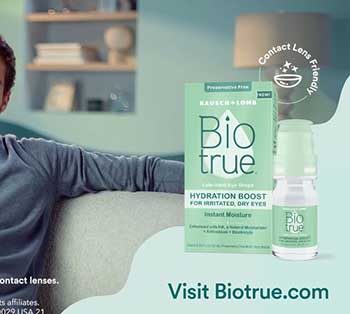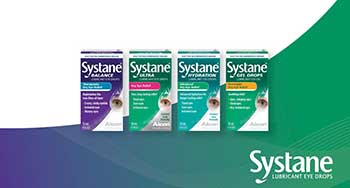If you suffer from dry, irritated eyes, you may have looked into artificial tear eye drops to provide relief. Two popular over-the-counter options are Biotrue and Systane lubricant eye drops.
But how do you know which one is right for you? Here, we’ll compare and contrast Biotrue and Systane eye drops to help you determine the best choice for your dry eye symptoms.
A Brief Comparison Table
| Feature | Biotrue | Systane |
| Manufacturer | Bausch + Lomb | Alcon |
| Key Ingredient | Hyaluronan | Polyethylene glycol |
| How it Works | Mimics natural tear film | Retains moisture |
| Cost for 10mL | $11-13 | $10-12 |
| Doses per Bottle | About 240 | About 160 |
| Effectiveness for Dry Eye | Similar to Systane in clinical studies | Proven relief in clinical studies |
| Side Effects | Mild eye irritation, blurred vision | Mild eye irritation, blurred vision |
| Best For | Moderate dry eye, want natural ingredient | Severe dry eye, maximum moisture |
Overview Of Biotrue And Systane
Biotrue and Systane are both artificial tear solutions designed to treat dry eye. They work by lubricating the eyes and helping to keep them moist.

Biotrue is made by Bausch + Lomb. It contains hyaluronan, which is a moisturizer that mimics the eyes’ natural tear film. Biotrue is designed to work with the eye’s natural processes to protect against irritation.
Systane is made by Alcon. It contains polyethylene glycol and propylene glycol, which help retain moisture in the eyes. Systane aims to provide long-lasting relief by addressing tear film instability.
While both products are effective, there are some key differences between Biotrue and Systane that may make one a better choice for some people.
Key Ingredients
The active ingredients in Biotrue and Systane eye drops are slightly different:
Biotrue contains:
- Hyaluronan – a moisturizer that mimics the eyes’ natural tear film
- Polyethylene glycol 400 – helps eye drops spread across the eye
- Polypropylene glycol – retains moisture
- Boric acid – balances pH
- Sodium borate – balances pH
- Sodium chloride – balances salt
Systane contains:
- Polyethylene glycol 400
- Propylene glycol – retains moisture
- Hydroxypropyl guar – helps eye drops spread across eye
- Borate, boric acid, and sodium borate – balance pH
- Sodium chloride – balances salt
The biggest difference is that Biotrue contains hyaluronan while Systane does not. Hyaluronan works like the eyes’ natural tear film to coat the eyes. Systane relies more on polyethylene glycol and propylene glycol for moisture.
Also Read: Choose Between Systane Ultra PF And Hydration PF.
How To Use Them
Biotrue and Systane eye drops can both be used as needed throughout the day. Follow these steps when applying them:
Biotrue:
- Wash hands before use.
- Twist off cap.
- Tilt head back and pull down lower eyelid.
- Apply 1 or 2 drops as needed in affected eye(s).
- Close eye(s) for 1-2 minutes after applying.
- Replace cap after use.

Systane:
- Wash hands before use.
- Twist off cap.
- Pull lower eyelid down and squeeze bottle to apply 1 or 2 drops as needed in affected eye(s).
- Close eyes for 1-2 minutes after applying.
- Replace cap after use.
Biotrue and Systane can both be used as often as needed. Use Biotrue or Systane when your eyes feel dry or irritated for relief.
Cost Comparison
When comparing the cost of Biotrue Vs. Systane eye drops, Systane is generally the more affordable option:
- Biotrue eye drops: A 10mL bottle costs around $11-13.
- Systane eye drops: A 10mL bottle costs around $10-12.
Biotrue is slightly more expensive than Systane. However, Biotrue bottles contain more doses (around 240 per bottle) than Systane (around 160 per bottle).
Consider getting the smaller, travel-size bottles of each to try them out before purchasing larger bottles. Coupons and sales can also help reduce the cost.
Effectiveness And Relief
When it comes to relief of dry eye symptoms like irritation, burning, and watery eyes, both Biotrue and Systane are effective.
In clinical studies comparing the two eye drops:
- Biotrue performed similarly to Systane Ultra in improving tear breakup time, reducing eye irritation, and improving blurred vision.
- Patients reported fast relief and long-lasting hydration with both Biotrue and Systane.
- Both products increased tear production and reduced dry eye symptoms within 4 weeks of use.
So while Systane has more “proven” results from clinical studies, Biotrue provides comparable relief according to research.
Anecdotally, patients seem to respond well to both eye drops. Many report both Biotrue and Systane as providing soothing relief from dryness and allowing them to wear contacts longer comfortably.
When it comes to eye redness, Systane may have a slight edge over Biotrue. The propylene glycol in it helps reduce redness. But both can aid in reducing irritation and inflammation.
Also Read: Is Systane Nighttime Gel Better Than Ointment?
Side Effects And Safety
Biotrue and Systane eye drops have similar safety profiles. Both are preservative-free, which reduces eye irritation.
Potential side effects are mild but may include:
- Temporary blurred vision after application
- Eye redness
- Eye pain or irritation
- Itchy eyes
- Headache
- Bad taste in the mouth
To reduce risks:
- Apply as directed and not more than recommended. Using too many drops can cause side effects.
- Avoid touching the tip of the bottle directly to the eye to prevent contamination.
- Discard if you notice any discoloration or particles.
As over-the-counter products, both are considered safe for most people. But consult your eye doctor first if you wear contacts or have any eye condition or injury.
Also Read: Comparison Between Plexaderm and Peter Thomas Roth Eye Products
Frequently Asked Questions (FAQ)
Yes, Systane can be safely used with other eye drops like artificial tears. However, you should space out use of different eye drops by at least 10-15 minutes. Allow the first eye drop to absorb before applying the second type.
Yes, Systane can be safely used daily. In fact, using Systane or any artificial tear regularly is recommended to continually lubricate eyes and prevent dry eye symptoms from worsening. Just be sure not to exceed the recommended dose on the packaging.
Yes, Biotrue is an effective over-the-counter eye drop that can provide relief from dry eye discomfort. Its main ingredient, hyaluronan, mimics the eyes’ natural moisture. In clinical studies, Biotrue performed well at improving dry eye symptoms like irritation, blurred vision, and tear breakup.
Also Read: Choose Between Blink Gel Tears And Blink Tears.
Bottom Line
When comparing Biotrue and Systane for dry eyes, both provide effective, lubricating relief. The biggest differences that may sway your choice:
Consider Biotrue if you want:
- An eye drop with an ingredient (hyaluronan) that mimics the eyes’ natural moisture
- Mild lubrication suitable for moderate dry eye
Consider Systane if you want:
- Maximum hydrating relief
- An eye drop focused mainly on retaining moisture
- Added relief from eye redness
You can try both Biotrue and Systane to see which eye drop formula you prefer. Use the smaller bottles first to test them out. Ultimately, both can provide much-needed lubrication and hydration for frustrating dry, irritated eyes when used as directed.
